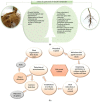Root Cultures, a Boon for the Production of Valuable Compounds: A Comparative Review
- PMID: 35161423
- PMCID: PMC8838425
- DOI: 10.3390/plants11030439
Root Cultures, a Boon for the Production of Valuable Compounds: A Comparative Review
Abstract
Medicinal plants are an inevitable source of pharmaceutical drugs and most of the world population depends on these plants for health benefits. The increasing global demand for bioactive compounds from medicinal plants has posed a great threat to their existence due to overexploitation. Adventitious root and hairy root culture systems are an alternative approach to the conventional method for mass production of valuable compounds from medicinal plants owing to their rapid growth, biosynthetic and genetic stability. The main purpose of this review is to investigate the recent scientific research published worldwide on the application of adventitious and hairy root cultures to produce valuable compounds from medicinal plants. Furthermore, a comparison of adventitious root vs. hairy root cultures to produce valuable compounds has also been discussed. Various aspects such as medium composition, carbon source, pH, amount of macronutrients, optimization strategy, scale-up cultures, and use of biotic abiotic and nano-elicitors at various concentrations are the topic of discussion in this review. Several studies on adventitious and hairy root cultures of Polygonum multiflorum¸ Withania somnifera¸ Echinacea purpurea and Ajuga bracteosa have been discussed in detail which highlights the importance of elicitation strategies and bioreactor system, presenting commercial applications.
Keywords: adventitious root culture; bioreactor; elicitation strategy; hairy root culture; medicinal plants.
Conflict of interest statement
The authors declare no conflict of interest.
Figures




References
-
- Wang J., Li J.L., Li J., Li J.X., Liu S.J., Huang L.Q., Gao W.Y. Production of active compounds in medicinal plants: From plant tissue culture to biosynthesis. Chin. Herb. Med. 2017;9:115–125. doi: 10.1016/S1674-6384(17)60085-6. - DOI
-
- Isah T., Umar S., Mujib A., Sharma M.P., Rajasekharan P.E., Zafar N., Frukh A. Secondary metabolism of pharmaceuticals in the plant in vitro cultures: Strategies, approaches, and limitations to achieving higher yield. Plant Cell Tissue Organ Cult. 2018;132:239–265. doi: 10.1007/s11240-017-1332-2. - DOI
-
- Kundu S., Salma U., Gantait S. Biotechnological Approaches for Medicinal and Aromatic Plants. Springer; Berlin/Heidelberg, Germany: 2018. Cryopreservation of Medicinal Herbs: Major Breakthroughs, Hurdles and Future; pp. 353–381.
Publication types
LinkOut - more resources
Full Text Sources
Molecular Biology Databases

